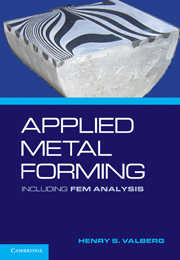Book contents
- Frontmatter
- Contents
- Preface
- APPLIED METAL FORMING
- 1 Characteristics of Metal Forming
- 2 Important Metal Forming Processes
- 3 FEA of Metal Forming
- 4 Theory
- 5 Reduction and Proportions of the Plastic Zone
- 6 Deformations from the Velocity Field
- 7 Technological Tests and Physical Simulation
- 8 Flow Stress Data
- 9 Formability and Workability
- 10 Friction and Friction Models
- 11 Thermal Effects
- 12 Experimental Metal Flow Analysis
- 13 Theoretical Methods of Analysis
- 14 Finite Element Analysis
- 15 FEA of Technological Tests
- 16 Forging
- 17 FEA of Forging
- 18 Extrusion
- 19 FEA of Extrusion
- 20 Rolling
- 21 FEA of Rolling
- 22 Drawing of Wire, Profiles, and Tubes
- 23 FEA of Wiredrawing
- 24 Sheet-Metal Forming
- Index
- References
14 - Finite Element Analysis
Published online by Cambridge University Press: 05 June 2012
- Frontmatter
- Contents
- Preface
- APPLIED METAL FORMING
- 1 Characteristics of Metal Forming
- 2 Important Metal Forming Processes
- 3 FEA of Metal Forming
- 4 Theory
- 5 Reduction and Proportions of the Plastic Zone
- 6 Deformations from the Velocity Field
- 7 Technological Tests and Physical Simulation
- 8 Flow Stress Data
- 9 Formability and Workability
- 10 Friction and Friction Models
- 11 Thermal Effects
- 12 Experimental Metal Flow Analysis
- 13 Theoretical Methods of Analysis
- 14 Finite Element Analysis
- 15 FEA of Technological Tests
- 16 Forging
- 17 FEA of Forging
- 18 Extrusion
- 19 FEA of Extrusion
- 20 Rolling
- 21 FEA of Rolling
- 22 Drawing of Wire, Profiles, and Tubes
- 23 FEA of Wiredrawing
- 24 Sheet-Metal Forming
- Index
- References
Summary
Lately, the most important advancement in metal forming analysis has been the development and application of finite element analysis (FEA), i.e., use of the computerized finite element method (FEM). Recent progress in FEA, together with increasingly powerful computers, has permitted increased use of such numerical modeling. Hence, today it is possible to FEM-simulate the metal forming processes at various design stages.
When a FEM model has been made for a particular forming application, the load requirement, velocity, strain rate, strain and stress fields, etc., can easily be obtained for the considered process. Therefore, the current trend is toward increased application of FEA for process simulation and optimization. For practical applications, the modeling techniques must, of course, describe experimental observations quantitatively with sufficient accuracy.
After an introduction to modeling techniques in general in metal forming, this chapter will focus on the application of FEM modeling as a practical tool to investigate the process conditions in forming operations. An overview of some commonly applied FEM codes will be given. Afterwards, it will be shown how the two- and three-dimensional versions of the DEFORM™ FEM program can be used to FEM-model metal forming.
Some examples will be presented where the DEFORM FEM code is used for deformation analysis in practical metal forming cases like plane strain compression and cylinder compression. Finally, a case will be presented where the complex conditions in extrusion welding are investigated by means of FEA. There is work being done to create corresponding models using QFORM. The DEFORM and QFORM models will be available at www.cambridge.org/valberg.
- Type
- Chapter
- Information
- Applied Metal FormingIncluding FEM Analysis, pp. 219 - 241Publisher: Cambridge University PressPrint publication year: 2010
References
- 1
- Cited by



